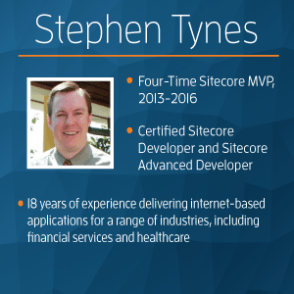Coveo has been partnering with the experts at Perficient, an award-winning Sitecore platinum implementation partner, to bring intelligent search to their clients. I’ve invited Stephen Tynes, Sitecore Practice Director at Perficient and a four-time Sitecore MVP, to share his experience on Coveo for Sitecore implementation projects.
 Marie: In your view, what impact can site search have on a site’s performance & user experience?
Marie: In your view, what impact can site search have on a site’s performance & user experience?
Stephen: Site search can have a significant impact on the user experience in several different ways. First off, we see that more and more users are searching for content rather than browsing for the content. As the overall volume of content on websites continues to increase, this trend will likely continue as well. So being able to index and surface the right content based on the user’s search term is of critical importance. Additionally, we have to anticipate what the user really intended to see based on their search term. That includes taking into account misspellings, common alternative terms and the like.
Secondly, while site search and SEO are separate considerations, they’re related. Many of our customers are using site search to create dynamic landing pages that aggregate content from across the site. For example, rather than having a specific page for “Search Optimization Trends,” the target may create a dynamic page that uses Coveo to pull various content including articles, blog posts, people who are experts on this topic, etc. from across the website. In this instance, search is actually being used to build the page itself. Another way that site search is becoming increasing important to the overall user experience on the website.
Marie: At what stage in a website project does the site search conversation come up?
Stephen: The short answer is typically far too late. Often time site search is an afterthought. A timeline and budget has already been set, expectations have already been communicated, and then the customer thinks about the site search experience. However, site search should be considered as one of the first things that’s typically evaluated as part of the overall strategy for the website.
As we described above, site search is relied upon more and more heavily for a positive user experience. Perficient typically evaluates this as part of our Inception phase which serves to set the tone for the entire project. We start defining a strategy and approach not only for site search but also for considerations like target audience, key scenarios, web analytics, device accessibility, content strategy and governance, etc. Like the analogy of putting rocks into the jar before the sand and water to ensure that the jar can be filled, considering these items at the outset of planning allows us to ensure that other requirements build upon these rather than the other way around.
Marie: What are the key things to look out for when integrating site search or replacing site search on an existing website?
Stephen: When we evaluate what kind of search experience is required, there are a couple of key things that we consider. From a technical standpoint we look at where the data is coming from? Is all of that data on the website? Is it coming from different web properties so we need to use Coveo’s web crawler? Are there other connectors that can be used or integrations that need to be built to access data in SharePoint or Salesforce or other platforms? Understanding this helps us to plan how involved from a technical standpoint setting up search may be. It also helps us identify what may be short term vs. long term objectives for search due to the level of complexity.
We also look at the expected volume of search requests and data to be stored. This helps us to begin planning for the necessary impact that the search requirements have on infrastructure, server setup, and considerations such as whether or not Coveo’s new Cloud Platform offering may be an alternative. This option allows Coveo to be configured for use on the website with potentially no impact on the hardware requirements of the site.
We also consider how the data is going to be presented to the users. One of the nice things about using Coveo is the number of UI controls that come out of the box. The controls allow for many basic functionalities including pagination, sorting, and filtering of search content. The Coveo UI controls can be skinned to align to the look and feel of the website and many times are good fit for the expected requirements. As with any 3rd party controls, there are limitations to the flexibility supported. So we normally look to see if this is a good fit for the requirements of the website because we can potentially save significant development effort when using these pre-built controls.
Marie: How could IT leaders extend a successful website search implementation to the rest of the organization?
Stephen: Once the search data has been aggregated across all of the different sources, most of our customers want to take full advantage of that data. Many times this extends beyond site search for a website and the customer begins to look at how to leverage the data in other places. And over time, the success we have with Coveo for site search leads to Coveo being used in more of an enterprise search capacity as the indexed data is used across other websites and intranets and other various clients.
This is also another place where Coveo’s new Cloud Platform can be very beneficial. Rather than adding hardware to scale for the additional volume of requests, Coveo’s Cloud Platform is already set up to support the expanding needs.
For more great insights from Stephen, watch the recording of our recent Milwaukee Sitecore Developers Meetup.



